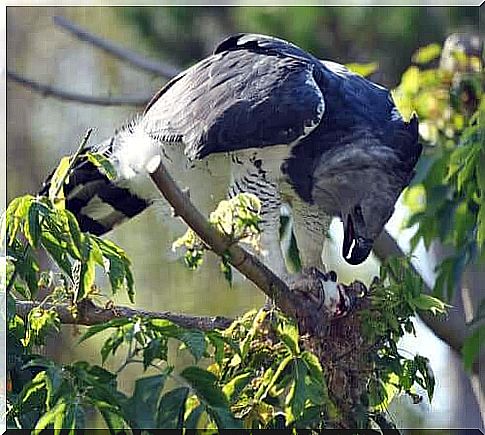The Harpy Eagle: Habitat And Characteristics Of A Majestic Animal

The harpy eagle ( Haria harpyja) is a species of diurnal bird of prey of the order Accipitriformes and belonging to the Accipitridae family. This is the largest eagle in the Western and Southern hemisphere, and the only species of the genus Harpia. This bird takes its name from the harpies, Greek mythological beings half woman and half bird.
Let’s find out more about the harpy eagle, a majestic bird of prey that flies over the skies. We will tell you where it lives, what it feeds on and we will give you a lot of other information.
Characteristics and habitat of the harpy eagle
The average dimensions of the harpy eagle female are 100 cm in length, 200 cm in wingspan (distance calculated from one end of one wing to the other), and a weight of around 9 kg. The male is smaller, with a wingspan of 196 cm and a weight of 8 kg. The harpy eagle’s body is generally stouter and longer than other large eagles.
In adults the head is white, with a typical slightly bizarre crest made of gray feathers which, when erect, resemble two large horns.
The back and wings are black, while the internal feathers of the wing and on the thorax are white. The upper part of the chest that connects to the head is crossed by a thick band of black feathers, while the tail is black with three gray stripes.
The beak is very dark gray: the grip is very strong like that of its claws, which can reach a length of 15 cm. It has a chocolate-colored or, more rarely, yellow iris. The skin on the legs is light yellow, while the nails are dark gray.
The harpy eagle lives in the rainforests still not totally contaminated by man, at a height that varies between 600 and 2,000 meters. Places that extend from the southeast of Mexico, passing through Central America (Belize, Guatemala, Honduras, Costa Rica, Nicaragua and Panama), Colombia, Bolivia, Peru, Ecuador, Venezuala, Guyana, Suriname and French Guiana, up to to the southeast of Brazil, to Paraguay and northern Argentina.

Feeding the harpy eagle
Its morphology is suitable for the habitat in which it hunts. Despite being wide in relation to the trunk, its wings are not too wide, and this allows it to fly among the thick canopies of trees.
The crest and the crown of feathers, in addition to serving as a warning signal, have the function of redirecting sounds towards his ears. With its keen eyesight it can quickly perceive the smallest movements of its prey among the thick foliage.
It is a predatory species: its favorite prey are arboreal mammals, including several species of monkeys, sloths, etc. It also feeds on birds such as the macaw and reptiles such as iguanas and snakes. It also feeds on medium-sized terrestrial species such as deer, pècari, armadillos and other species.
Reproduction
They are observed in pairs only during the period of reproduction; for the rest of the year it is a solitary bird. The reproductive age of this eagle begins at 4 or 5 years and reproduces approximately every 2 or 3 years. His life expectancy reaches up to 40.

It builds its nest with branches and dry sticks among the branches of the trees at a height between 20 and 50 meters high. The nest can measure up to two meters in diameter and weigh 100 kg. They build it in pairs.
Harpy eagles lay one or two eggs, and if two chicks are born, only one survives. The eggs hatch after 56 days of hatching.
During the incubation period, the male provides food to the female. When the puppy is born, both parents take turns to feed it, although as it grows the male regularly stops taking care of it, leaving it to the female only. The baby grows slowly and continues to need parents for at least the first three years after birth.

storage
In the Red List of the International Union for Conservation of Nature, the harpy eagle is listed as a nearly threatened species. This is due to the slow but steady decline in the populations of this bird over time. The demographic trend is in fact descending and it is estimated that today fewer than 50,000 individuals remain.
The destruction of its habitat is facilitating the disappearance of the harpy eagle in much of its biogeographical area, leading it to disappear almost entirely in Central America. In Argentina it has become extinct in some areas and is considered endangered, in Colombia it is considered almost threatened, in Ecuador it is vulnerable and in Venezuela it is at risk of extinction.
The threats affecting this species come from the progressive loss of their habitat as a result of hunting and deforestation, factors that not only affect the species but also indirectly on the animals it feeds on.
Unlike other countries, in Panama it is considered the national bird and is therefore protected, even appearing on the national coat of arms. In addition, there is a conservation program in Ecuador that works with the communities where the harpy eagle lives.
In 1992 the Harpy Eagle Conservation Project was launched in Venezuela, an initiative with the main objective of preserving the animal’s population in the country, creating ecological corridors that allow genetic exchange between the different populations of the country.









